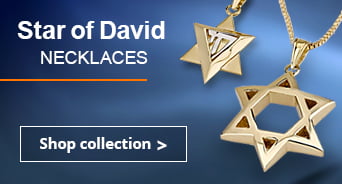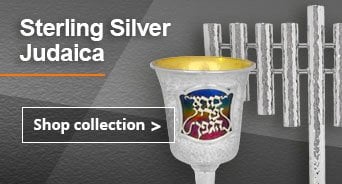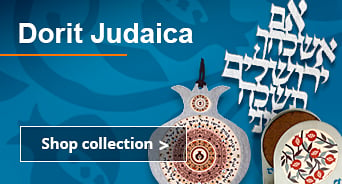14K Gold Kyanite Aquamarine Diamond Hamsa Necklaces & Pendants
Hamsa necklaces by leading Israeli artists, traditional protective amulets with modern style and elegance.


Hamsa pendants and necklaces have been some of the most popular forms of Jewish jewelry for centuries. Judaica Webstore's collection of Hamsa necklaces and pendants has wonderful hamsas, both traditional and contemporary, in sterling silver or gold, and with precious stones, Roman glass, and many other beautiful decorations!
What does the Hamsa mean?
Originating in North Africa and the Middle East, the hand-shaped Hamsa symbol represents divine protection against the evil eye as well as blessings and power. Due to its association with protection against the evil eye, many Hamsas feature an eye symbol in its palm.
Can anyone wear the Hamsa hand?
Although viewed as a symbol of divine protection, the Hamsa is not a religious item and there is no issue with anyone, Jewish or non-Jewish, choosing to wear this amulet.
If you are looking to buy a Hamsa for yourself or a loved one, our collection of Hamsa Necklaces and Pendants will surely have what you need!
What is the significance of the Hamsa in Judaism?
Hung in homes as an amulet and worn as a talisman on necklaces and other jewelry, the Hamsa is a symbol of Divine protection and is Judaism’s most famous good-luck charm!
It’s believed to safeguard from negative energies and the Evil Eye, and to bring luck, happiness, success, fortune, and harmony.
In Judaism, some people also connect the Hamsa with the Exodus from Egypt, as it says that "God took Israel out of Egypt with a strong hand and an outstretched arm." Some Jews also view the five fingers of the Hamsa as a reminder to serve God with all five senses.
The Hamsa is often used in kabbalah and Jewish mysticism, as a symbol of holiness and Creation, with the power to neutralize negative energies and forces as well as protect from unseen dangers.
Where does the Hamsa come from in Judaism?
The Hamsa is one of the oldest Jewish symbols; its imagery has been found on ancient Israelite tombs dating all the way back to the 8th century BCE!
Over time it became a common Middle Eastern and North African motif, often used by Sephardic Jews and adopted by non-Jewish traditions as well. It is also sometimes called the "Hand of Miriam" or the "Palm of David."
The Hamsa is depicted as an open right hand, often with an eye in the center of the palm and sometimes adorned with fish or other symbols of protection and luck. The hand can either be pointing up or down, fingers spread or close together, and many believe even the smallest of details have an impact in the Hamsa's protection.
The practice of specifically wearing or keeping a Hamsa amulet in one’s home for protection has been found all over the Middle East, North Africa, and Jewish communities in both Israel and the diaspora for centuries.
What materials are used on Hamsa necklaces?
We carry Hamsa necklaces and pendants in high quality materials at a variety of price points, including sterling silver, gold-plated silver, 18K gold, and 14K gold.
Some of our Hamsa necklaces are adorned with additional materials such as diamonds, Eilat stone, rubies, or sapphires.
Is a Hamsa necklace suitable for everyday wear?
Whether for special occasions or everyday wear, our Hamsa necklaces are suitable for wearing any way or any time you like!
You can find a variety of styles, materials, and price points, with something for everyone for any outfit or budget.






